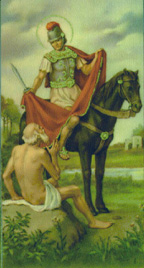Hairshirt
FREE Catholic Classes
(Latin cilicium ; French cilice ).
A garment of rough cloth made from goats' hair and worn in the form of a shirt or as a girdle around the loins, by way of mortification and penance. The Latin name is said to be derived from Cilicia, where this cloth was made, but the thing itself was probably known and used long before this name was given to it. The sackcloth, for instance, so often mentioned in Holy Scripture as a symbol of mourning and penance, was probably the same thing; and the garment of camels' hair worn by St. John the Baptist was no doubt somewhat similar. The earliest Scriptural use of the word in its Latin form occurs in the Vulgate version of Psalm 34:13, "Ego autem, cum mihi molesti essent, induebar cilicio." This is translated hair-cloth in the Douay Bible , and sackcloth in the Anglican Authorized Version and the Book of Common Prayer.
During the early ages of Christianity the use of hair-cloth, as a means of bodily mortification and as an aid to the wearer in resisting temptations of the flesh, became very common, not only amongst the ascetics and those who aspired to the life of perfection, but even amongst ordinary lay people in the world, who made it serve as an unostentatious antidote for the outward luxury and comfort of their lives. St. Jerome, for instance, mentions the hairshirt as being frequently worn under the rich and splendid robes of men in high worldly positions. St. Athanasius, St. John Damascene, Theodoret, and many others also bear testimony to its use in their times. Cassian, however, disapproved of it being used by monks, as if worn outside it was too conspicuous and savoured of vanity and if underneath it hindered the freedom of the body in performing manual labour. St. Benedict does not mention it specifically in his rule, but van Haeften maintains that it was worn by many of the early Benedictines, though not prescribed universally throughout the order.
Later on, it was adopted by most of the religious orders of the Middle Ages, in imitation of the early ascetics, and in order to increase the discomfort caused by its use it was sometimes even made of fine wire. It was not confined to the monks, but continued to be fairly common amongst lay people also. Charlemagne, for instance, was buried in the hairshirt he had worn during life (Martene, "De Ant. Eccl. Rit."). The same is recorded of St. Thomas of Canterbury . There was also a symbolic use made of hair-cloth. St. Augustine says that in his time candidates for baptism stood with bare feet on hair-cloth during a portion the ceremony (De Symb. ad Catech., ii, 1). Penitents wore it on Ash Wednesday, and in the Sarum Rite a hair-cloth banner was carried in procession at their reconciliation on Maundy Thursday. The altar, too, was sometimes covered with the same material at penitential seasons.
In modern times the use of the hairshirt has been generally confined to the members of certain religious orders. At the present day only the Carthusians and Carmelites wear it by rule; with others it is merely a matter of custom or voluntary mortification. Objections have been raised against its use on sanitary grounds, but it must be remembered that ideas as to personal cleanliness have changed with the advance of civilization, and that what was considered a sign of, or aid to, piety in past ages need not necessarily be regarded in the same light now, and vice versa, but the ideas and practices of the ancients must not for that reason be condemned by us, because we happen to think differently.
Join the Movement
When you sign up below, you don't just join an email list - you're joining an entire movement for Free world class Catholic education.
-

-
Mysteries of the Rosary
-
St. Faustina Kowalska
-
Litany of the Blessed Virgin Mary
-
Saint of the Day for Wednesday, Oct 4th, 2023
-
Popular Saints
-
St. Francis of Assisi
-
Bible
-
Female / Women Saints
-
7 Morning Prayers you need to get your day started with God
-
Litany of the Blessed Virgin Mary
The Power of the Rosary: Why Praying the Rosary Matters for Catholics
-

Lasers Reveal Hidden Mayan City of Valeriana with 6,500 Structures in Mexico
-

Embracing Peace and Unity in a Time of Division
-
The 'Black Legend': Historian Argues Anti-Catholic Bias in Spanish Conquest Narratives
-
This Catholic Hero Who Fought Against Communism Should Be Released Immediately
Daily Catholic
 Daily Readings for Monday, November 11, 2024
Daily Readings for Monday, November 11, 2024 St. Martin of Tours: Saint of the Day for Monday, November 11, 2024
St. Martin of Tours: Saint of the Day for Monday, November 11, 2024 Prayer for Deceased Veterans: Prayer of the Day for Monday, November 11, 2024
Prayer for Deceased Veterans: Prayer of the Day for Monday, November 11, 2024- Daily Readings for Sunday, November 10, 2024
- St. Leo the Great: Saint of the Day for Sunday, November 10, 2024
- Evening Prayers: Prayer of the Day for Saturday, November 09, 2024
![]()
Copyright 2024 Catholic Online. All materials contained on this site, whether written, audible or visual are the exclusive property of Catholic Online and are protected under U.S. and International copyright laws, © Copyright 2024 Catholic Online. Any unauthorized use, without prior written consent of Catholic Online is strictly forbidden and prohibited.
Catholic Online is a Project of Your Catholic Voice Foundation, a Not-for-Profit Corporation. Your Catholic Voice Foundation has been granted a recognition of tax exemption under Section 501(c)(3) of the Internal Revenue Code. Federal Tax Identification Number: 81-0596847. Your gift is tax-deductible as allowed by law.






 Daily Readings for Monday, November 11, 2024
Daily Readings for Monday, November 11, 2024 St. Martin of Tours: Saint of the Day for Monday, November 11, 2024
St. Martin of Tours: Saint of the Day for Monday, November 11, 2024 Prayer for Deceased Veterans: Prayer of the Day for Monday, November 11, 2024
Prayer for Deceased Veterans: Prayer of the Day for Monday, November 11, 2024


